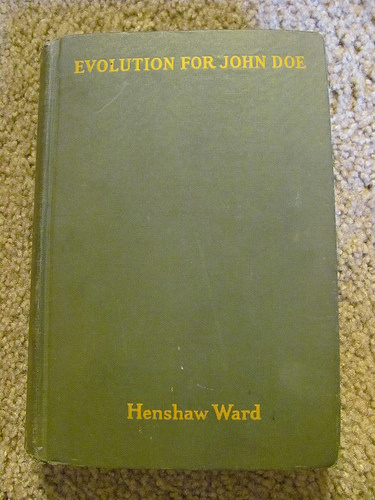
Still on the agenda is Henshaw Ward’s Evolution for John Doe (1925), a popular exposition of evolution from the Scopes era, by a teacher of English turned science popularizer, who claimed that for twenty years he sought a popular treatment of evolution to recommend to the curious, but without success. “Apparently biologists know so much of the details that they can not [sic] write a brief account of the whole theory.” I am particularly interested in its distinctive first chapter, “What John Doe Thinks about Evolution,” which not only lists what Ward takes to be prevalent misconceptions about evolution but also explains how the book attempts to defuse them. I described the book in general in part 1, and discussed the first two misconceptions—that “evolution is ‘the doctrine that man is descended from monkeys’” and that “evolution explains the origin of life”—in part 2. Ward chose to omit both the topic of human evolution and the topic of the origin of life. What about the remaining six misconceptions?
The third misconception: “John Doe thinks that evolution has something to do with “‘progress.’” There’s no question that such a misconception is prevalent. Part of the reason, perhaps, is the traditional Great Chain of Being, according to which all of creation is organized under God into a hierarchy extending from angels through humans (with monarchs over nobles over commoners, of course) to animals, plants, and minerals. Although Darwin warned himself “to never say higher and lower,” the temptation to regard evolution as progressive is ubiquitous (as Michael Ruse details in Monad to Man: The Concept of Progress in Evolutionary Biology [1997]), with Ernst Haeckel and (in Ward’s day) Henry Fairfield Osborn conspicuously succumbing to it. Ward’s solution is to disavow any commitment to “an onward and upward movement toward perfection” in the first chapter of his book and again as needed (especially in the chapter on natural selection); Richard Dawkins takes a similar approach in The Greatest Show on Earth (2009), in a section aptly entitled “The Pernicious Legacy of the Great Chain of Being.”
The fourth misconception: “there is something mystical and awesome about ‘Evolution,’ especially if it is printed with a large E.” The solution is not only typographical, to print evolution with a small e, but also clarificatory: evolution, for Ward, is “only the very plain scientific theory that every form of plant or animal that ever lived developed out of a previous form.” No explanation of what the devotees of Evolution think is provided—I thought that he might have Herbert Spencer or Henri Bergson or C. Lloyd Morgan, with their vaporous philosophical ideas about Evolution, in mind, but Spencer is mentioned only once and in passing and Bergson and Lloyd Morgan not at all. Perhaps because Evolution with a large E and evolution with a small e have been increasingly distinguished over the years, with the former enjoying even less in the way of scientific authority than in the 1920s, neither The Greatest Show on Earth nor Alan R. Rogers’s The Evidence for Evolution (2011) nor Jerry Coyne’s Why Evolution is True (2009) seem to disclaim or discuss any form of it.
The fifth misconception: “John Doe guesses that evolution is true, but he rather wishes it were not.” He wishes that it was not true, Ward explains, because “he has a vague fear that the theory is materialistic and tends to weaken religious faith.” His solution is to cite, in the final chapter of Evolution for John Doe, the opinions of prominent members of the clergy who accepted or were at least open to evolution: Charles Kingsley (1819–1875), a clergyman and novelist who corresponded with Darwin; Henry Drummond (1851–1897), a theologian who like Kingsley regarded “the God of evolution [as]…infinitely grander than the occasional wonder-worker”; and Harry Emerson Fosdick (1878–1969), a Baptist minister heavily involved in the fundamentalist/modernist controversy in the 1920s. (Also mentioned was Bertram C. A. Windle [1858–1929], a Catholic scientist who wrote to The New York Times in 1922 to describe the attitude of the Catholic Church toward evolution—neutral, in short). The last two pages of Ward’s book, excluding the index and bibliography, reprint a Fosdick essay replying to William Jennings Bryan.
Ward’s solution is pro forma, perfunctory, and unconvincing. After all, creationists have religious authorities of their own to cite: why would they be impressed by the likes of Kingsley, Drummond, or Fosdick? Surely a less perfunctory treatment would involve any author in a mare’s nest of theological puzzlement, though, so perhaps Ward can be forgiven. I suspect that the most effective way to address the fifth misconception is not in works aimed at the general public but in works composed from within the perspective of particular faith traditions, appealing to their distinctive beliefs and concerns. That seems to be what Karl W. Giberson and Francis S. Collins were doing in The Language of Science and Faith (2011), and what BioLogos, founded by Collins, is continuing to do, among evangelical Christians, for example. In their books, Dawkins, Coyne, and Rogers generally steer clear of addressing the misconception at all (although elsewhere, of course, Dawkins and Coyne openly embrace the view that evolution indeed weakens religious faith). To be continued in part 4.

